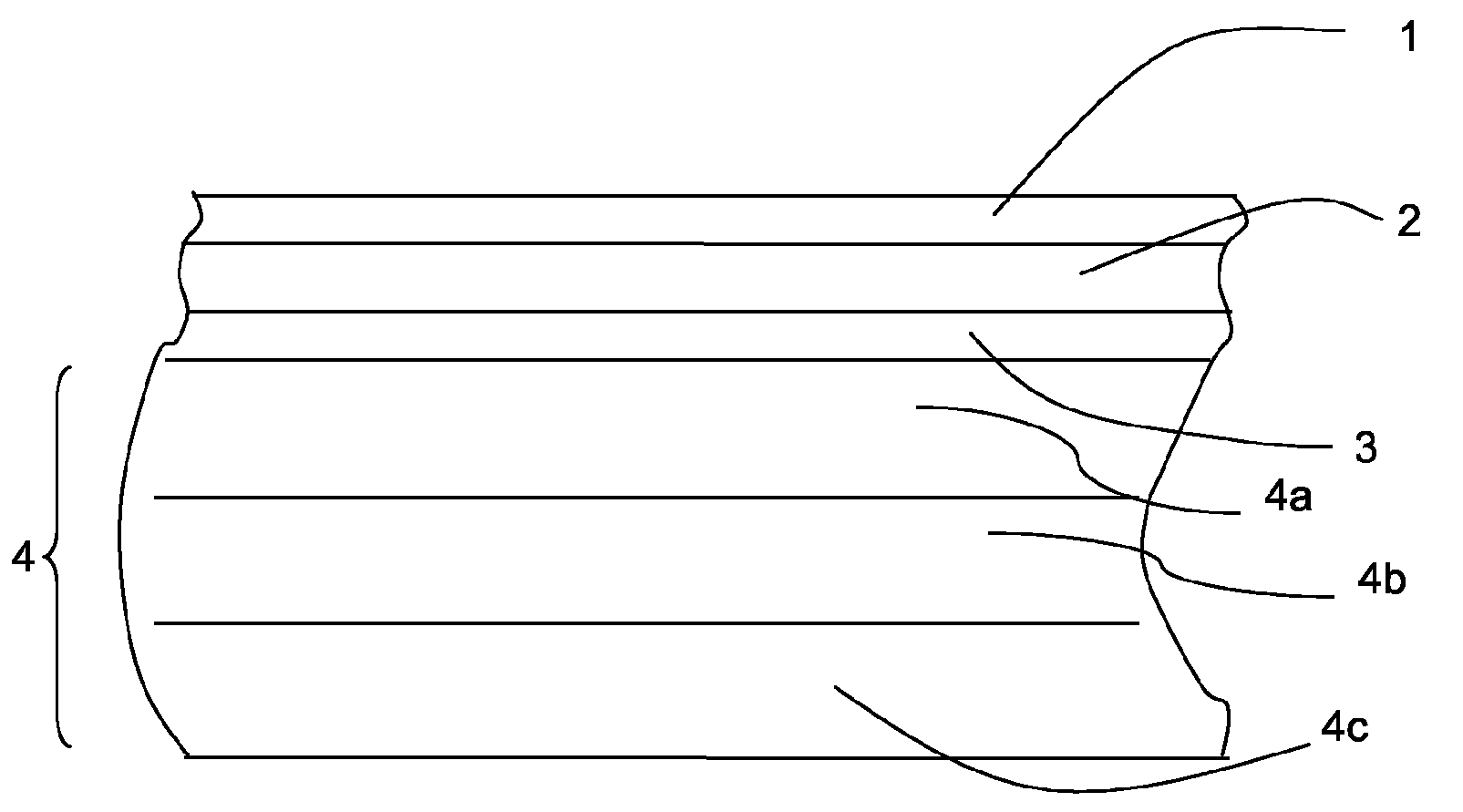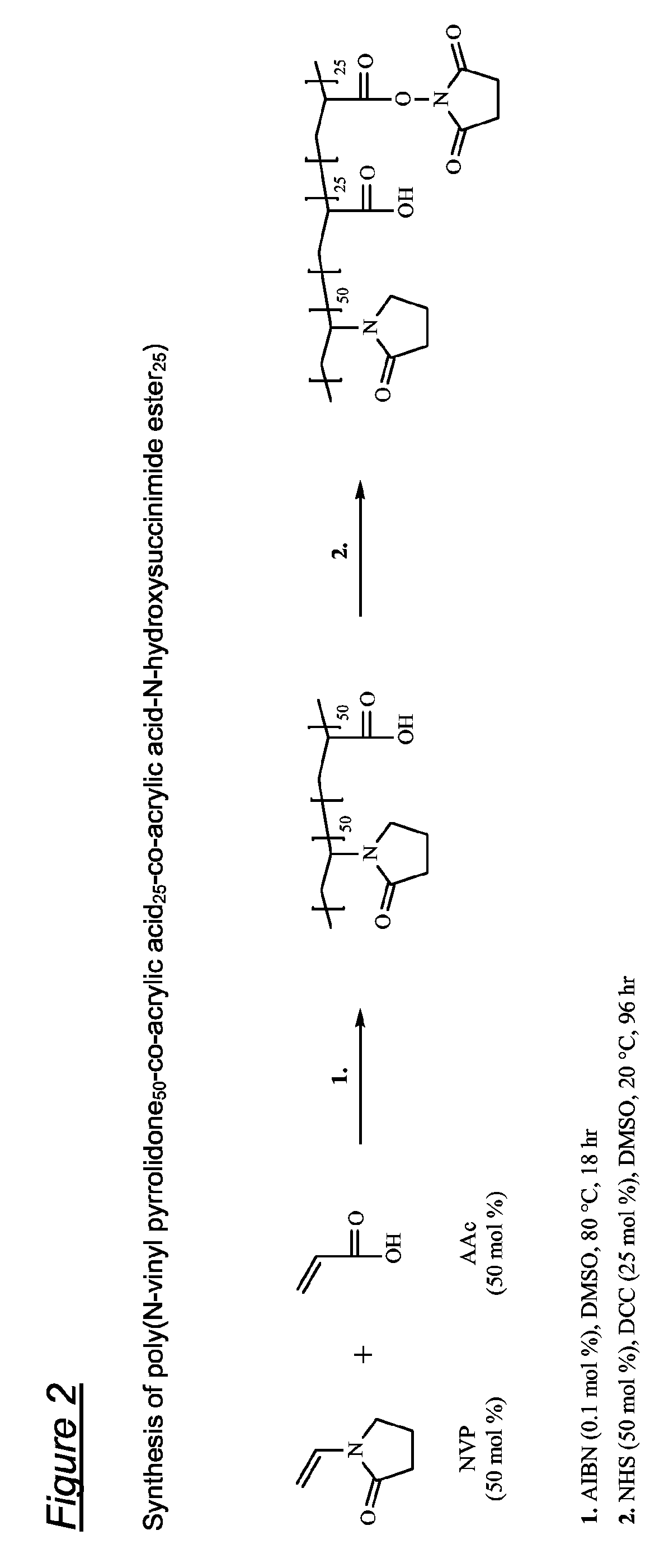Tissue-adhesive materials
- Summary
- Abstract
- Description
- Claims
- Application Information
AI Technical Summary
Benefits of technology
Problems solved by technology
Method used
Image
Examples
example 1
Preparation of Multi-Lamellar Sheet
[0091]A multi-lamellar tissue-adhesive sheet according to the invention is shown schematically in FIG. 1. The sheet comprises a structural laminate and a tissue-contacting layer.
[0092]The structural laminate has the form of:
a) a first layer 1 of PLGA;
b) a second layer 2 of poly(VP-AAc-AAc(NHS)); and
c) a third layer 3 of PLGA.
[0093]The tissue-contacting layer 4 is conjoined to the third layer 3 and comprises poly(VP-AAc-AAc(NHS)).
[0094]The first and third layers 1,3 each have a thickness of approximately 4 μm, and the second layer 2 a thickness of approximately 3 μm. The tissue-contacting layer 4 has a thickness of approximately 22 μm, and consists of three sub-layers 4a-c of approximately equal thickness.
[0095]The sheet is prepared as follows:
1.1 Preparation of Solutions
[0096]Three solutions are prepared as follows:
[0097]Solution A is 10 g PLG dissolved in 100 ml DCM.
[0098]Solution B is 7.5 g poly(VP-AAc-AAc(NHS)) dissolved in 100 ml DCM / MeOH 15 / 4....
example 2
Alternative Preparation of Multi-Lamellar Sheet
[0109]A two-layer tissue-adhesive sheet according to the invention comprises a structural layer and a tissue-contacting layer.
[0110]The structural layer has the form of a single, first layer 1 of PLGA;
[0111]The tissue-contacting layer 2 is conjoined to the first layer 1 and comprises poly(VP-AAc-AAc(NHS)).
[0112]The first layer 1 has a thickness of approximately 15 μm. The tissue-contacting layer 2 has a thickness of approximately 22 μm.
[0113]The sheet is prepared as follows:
2.1 Preparation of Solutions
[0114]Three solutions are prepared as follows:
[0115]Solution A is 10 g PLG dissolved in 100 ml DCM.
[0116]Solution B is 10 g poly(VP-AAc-AAc(NHS)) dissolved in 100 ml DCM / MeOH 15 / 4.
[0117]Solution C is 2.5 g methylene blue dissolved in 50 ml water.
2.2 Casting of Layer 1
[0118]Solution A is cast onto silicone backed release paper using a device referred to as a K bar. The film is dried for 30 minutes at 20° C. / atmospheric pressure. The film is...
example 3
[0123]The in vitro adhesive performance to liver of a sheet according to the invention has been quantified using a Zwick universal testing machine. After 5 minutes immersion in DPBS, the mean work of adhesion is typically 7 to 14 mJ.
PUM
| Property | Measurement | Unit |
|---|---|---|
| Fraction | aaaaa | aaaaa |
| Thickness | aaaaa | aaaaa |
| Thickness | aaaaa | aaaaa |
Abstract
Description
Claims
Application Information
 Login to View More
Login to View More - R&D
- Intellectual Property
- Life Sciences
- Materials
- Tech Scout
- Unparalleled Data Quality
- Higher Quality Content
- 60% Fewer Hallucinations
Browse by: Latest US Patents, China's latest patents, Technical Efficacy Thesaurus, Application Domain, Technology Topic, Popular Technical Reports.
© 2025 PatSnap. All rights reserved.Legal|Privacy policy|Modern Slavery Act Transparency Statement|Sitemap|About US| Contact US: help@patsnap.com



